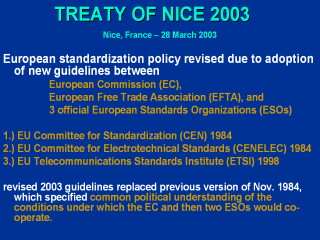| front |1 |2 |3 |4 |5 |6 |7 |8 |9 |10 |11 |12 |13 |14 |15 |16 |17 |18 |19 |20 |21 |22 |23 |24 |25 |26 |27 |28 |29 |30 |31 |32 |33 |34 |35 |36 |37 |38 |39 |review |
 |
Abbreviations: CIOMS, Council for International
Organizations of Medical Sciences; NBAC, National Bioethics Advisory
Commission; UNAIDS, United Nations Programme on HIV/AIDS; WMA, World Medical
Association NEW STANDARDS GUIDELINES FOR EUROPE Nice, France – 28 March 2003 European standardization policy has been brought up to date today as the result of the adoption of new guidelines between the European Commission (EC), the European Free Trade Association (EFTA), and the three official European Standards Organizations (ESOs). These new guidelines were signed today in Nice, France, by Erkki Liikanen, the EC Commissioner responsible for Enterprise & Information Society, EFTA Secretary-General William Rossier, and senior representatives of the three standards organizations. The signing ceremony took place during a conference on "Accessibility for all", organized by the ESOs - a conference that was set in the context of 2003 being designated the European Year of People with Disabilities, and which reflected the key role that standards play in the life of all people, regardless of their age and ability. The guidelines replace the previous version established in November 1984, which laid down for the first time a common political understanding of the conditions under which the EC and the then two ESOs, the European Committee for Standardization (CEN) and the European Committee for Electrotechnical Standardization (CENELEC), would co-operate. Equivalent guidelines were signed between these ESOs and EFTA in 1985. Since then, many changes have taken place in Europe and beyond, economically, technologically, at a regulatory level and in standardization itself. As an example, the creation of the European Telecommunications Standards Institute (ETSI) in 1988 contributed significantly to the restructuring of the European standardization process that was already under way (ETSI subsequently received official recognition as an ESO alongside CEN and CENELEC in the EC Directive 98/34/EEC). This process has become increasingly …/… 2 open to all interested parties and considerably more responsive to the very tight timescales of today's technological developments, and the demands for technical quality. As a result, European standardization is now extremely dynamic; for instance, over the last ten years the number of European Standards available has risen from 2000 to more than 14 000 – and the number continues to grow by more than 1000 annually. These figures illustrate the huge demand from industry in all sectors for standards that help ensure products and services are safe, fit for their purpose and compatible. European standards provide a powerful means of enhancing the competitiveness of companies in Europe and creating the single European market. This success also ensures Europe a very powerful position in world-wide standardization. The progressive widening of European policy since the original guidelines were first drawn up has created a role for standards in support of issues such as safety in the workplace, and protection of consumers and the environment. The new guidelines also recognize the EC/EFTA "New Approach", under which standards provide technical solutions for presumption of conformity with legal requirements; the guidelines thus include a mutual commitment to use standardization to support legislation. These developments in policy have, in turn, encouraged wider participation in European standards-making by non-governmental economic and social interest groups, and has generated greater openness of the European standard-setting process. As a result, all sectors of society now benefit greatly from this efficient and well-structured European standardization framework, based upon the three independent ESOs. The signatories welcomed the new guidelines as a further strengthening of the co-operation between the political and technical communities in Europe. They declared their conviction that the new agreement constitutes a solid basis for future collaboration and a reinforcement of the role of European standardization in support of European policy. Commissioner Liikanen emphasized in addition the great importance given by the signatories in the guidelines to the participation of non-governmental economic and social interest groups in the standards-setting process. The new Guidelines will appear shortly in the Official Journal of the European Communities and thus be available in all the official Community languages. |